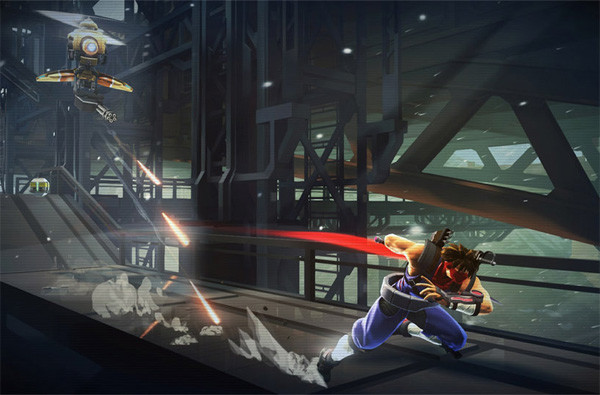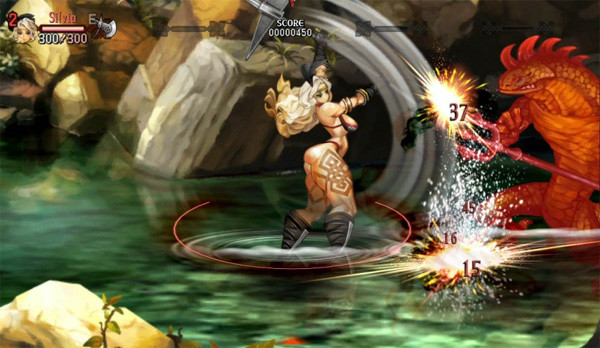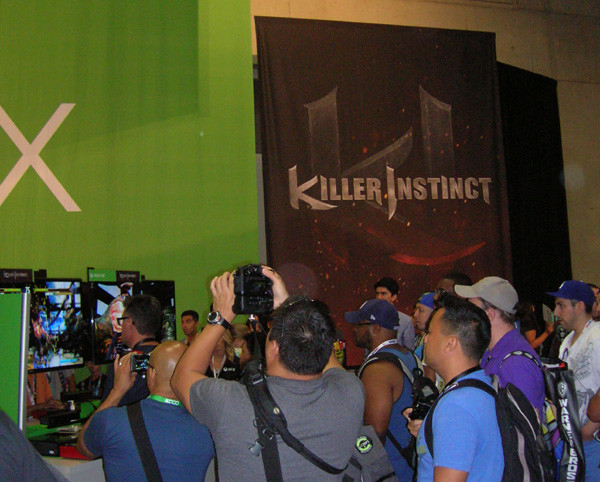San Diego Comic-Con International 2013
The X Button at Comic Con: Thursday, July 18
by Todd Ciolek,
CAPCOM REVIVES STRIDER, TAKES IT TO GRAY COUNTRY
Certain Capcom series live in early retirement. They're not as obscure as Varth or Three Wonders, but they're not exactly revived for sequels every fall. Strider is one of these part-timers. It began as a three-part project between Capcom and the manga studio Moto Kikaku, inspiring an arcade classic, an NES kinda-classic, and a short, obscure comic. Revamps and sequels were attempted over the years, but Strider's most prominent legacy seemed to be its protagonist Hiryu's appearance in various Marvel vs. Capcom games.
That changed at the San Diego Comic Con today, when Capcom's Andrew Szymanski introduced the company's first real Strider revisiting since 1999's Strider 2. An opening playthrough showed off some typical Strider flourishes as blue-clad ninja Hiryu, now equipped with a plasma scarf, zipped around, slashing heli-robots and android guards. New elements were at play, though as Hiryu uncovered new weapons for his cipher sword: a bullet reflector, a fiery edge that sets enemies ablaze, and a chargeable, larger arc of damage. These new abilities are key to the game's Metroid-like progression, as new weapons open certain doors throughout the levels.

Capcom's new Strider clearly tries to evoke the Cold War mystique of the original's opening stage, as both feature Hiryu hang-gliding into a Kazakh city and slicing through its army. Yet the aesthetic is stark, all gray scaffolding and empty politburo halls. The early footage of the game also didn't show too much variety in the enemies facing Hiryu, a clear contrast to the original Strider's array of weird and constantly changing opposition. Still, this new Strider clearly has that sense of speed in mind.
“Keeping it fast the entire time was very important for us,” Szymanski said.
The game is currently in development at Double Helix, makers of Front Mission Evolved and Silent Hill: Homecoming. That may not suggest the brightest future for Strider, but Capcom seems intent on guiding the project in the tradition of the arcade classic. Double Helix is working in concert with a team at Capcom's Osaka location, the members of which include a Strider 2 artist and a designer from Super Ghouls & Ghosts and other Capcom arcade games.
What won't the next Strider have? Ties to the NES game, it seems. The 8-bit Strider was a glitchy affair destined to live in the shadow of its arcade relative, but it told a globe-hopping story complete with light Metroid-ish exploration. While that's similar to what the new Strider envisions, Capcom didn't mention the NES title when recounting Strider history, and there's no sign of its characters or plot (or any plot) in what we've seen of the new Strider thus far. The game's due out next year for Xbox Live, the PlayStation Network, and Steam, so there's ample time for Capcom to show more of it.
DRAGON'S CROWN
The Comic-Con sample of Dragon's Crown confirms what many suspect about the game's sorceress and amazon characters, instruments of many complaints about sexism in the game industry. They're ridiculous, and it isn't something confined to a few illustrations or frames of animation. Every little movement they make, be it dashing or jumping or firing a crossbow, is indistinguishable from a far too on-the-nose parody of how fantasy games sexualize female characters. Nor can the player escape this entirely by picking another character. Even if you play as the towering knight or the nimble elf, you're never far from a giant-breasted magic merchant or even a meandering townswoman whose animations would be gratuitous in a more reserved game.

But enough about that. Setting aside the character design, Dragon's Crown seems a solid brawler in the arcade tradition: six characters, four players, and a beautifully animated Vanillaware sheen to it all. The controls revise some typical features of the genre; characters dash by holding down a button instead of double-tapping, for example. Combat itself has a pleasant array of attacks, double-jumps, blocking, and other maneuvers. There's little of the sluggishness that nagged at Odin Sphere, and while the demo seemed easy, it suggested few unfair challenges in the final game.
Dragon's Crown also showed curious favor to the modern conventions of tutorials and prepwork. For all of the game's extolled throwbacks to quick-and-fun brawlers, it still introduces the player to control features that they could just as easily discover while playing. Other contemporary features seem intended to put more meat on the game. Players can manage and customize multiple characters at the game's tavern, and the game uses the Vita's touch screen to helpfully pick out items. It's a shame that Dragon's Crown won't be playable across the PlayStation 3 and Vita, but it may impress on either system.
KILLER INSTINCT
Say what you will about the two Killer Instinct games. They looked stiff and plastic, and they unimaginatively snatched up every stereotype in fighting games. Yet they were also unlike anything else in the mid-1990s. A hyper-excited announcer screaming “ULTRA COMBOOOOO” while a T-1000 alien pounded a velociraptor into the ionosphere was silly, but it was precisely the sort of thing kids wanted for the better part of 1995. The revived Killer Instinct is a surprising comeback, and it seems to draw more attention that much of the other Xbox One launch exclusives, but it doesn't quite stand apart.

The demo at Comic-Con resembled what we saw of the game at E3, though this time around it was running on actual Xbox One consoles. Jago and Sabrewulf were the only playable characters, with the latter looking much like his Killer Instinct one incarnation. The whole thing felt very much like Street Fighter IV in its detailed 3-D masquerading as 2-D gameplay, and the similarities ran down to the overall flow of the gameplay (plus Jago's typical Ken-and-Ryu moves). Why choose it over the actual Street Fighter IV? That'll be a hard question for Microsoft to answer.
discuss this in the forum (3 posts) |
back to San Diego Comic-Con International 2013
Convention homepage / archives